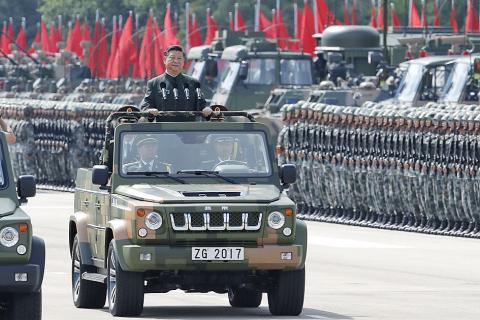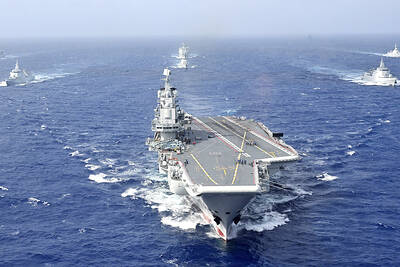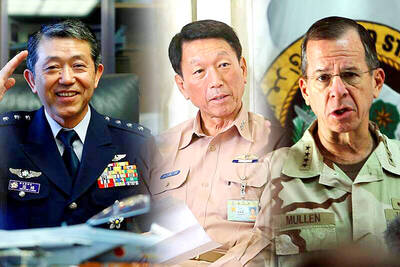China has finalized a clandestine plan to invade Taiwan in 2020 by launching missile attacks, blocking the nation’s air and sea space, and carrying out amphibious landings, Washington-based think tank Project 2049 Institute research fellow Ian Easton said.
Easton, a former student at National Chengchi University, made the “revelation” in his new book, The Chinese Invasion Threat, released on Tuesday.
The two sides of the Taiwan Strait have been two different nations since 1949, and most analysts believe that as long as Taiwan does not declare de jure independence, the “status quo” across the Strait would be maintained, Easton said.

Photo: AP
However, conflict could still arise no matter what Taiwan or the US does to prevent it given the unstable situation in the Taiwan Strait, just like a levee that has been under enormous pressure and ultimately breaks, he said, adding that Washington should focus on formulating new thinking that would accentuate that Taiwan is a sovereign and free nation.
The US’ arms sales to Taiwan was the biggest factor helping Taiwan to be involved in international politics, but it is unwise for Taiwan and the US to continue increasing arms sales in bilateral relations, Easton said.
US military officials holding a two-star rank or above should make regular visits to Taiwan so that Washington could make useful assessments in the event of a crisis, he said, adding that the two sides should conduct bilateral port-of-call stops, hold joint military drills and engage in defense industry exchanges to streamline efforts in providing humanitarian aid and disaster relief, and in counterterrorism and cyberwarfare.
It would be difficult for the US to maintain a military edge over China in the long term, unless it includes Taiwan in its strategic planning, Easton said, adding that it would likewise be impossible for Taiwan to ensure its security without maintaining the US’ support.
Taiwan’s counterattack capabilities pose a threat to the Chinese People’s Liberation Army (PLA), but it should expand its arsenal of long-range and shoulder-launched missiles, drones, fighter jets and cannons, and deploy weapons with lower lethality in areas closest to China, he said.
Easton also highlighted the need for Taiwan to understand the complexity of PLA tactics for launching an assault in its outlying Penghu, Kinmen and Lienchiang islands and for it to boost its abilities to engage in electronic warfare.
The US and China are engaged in a long and tense strategic race in the Asia-Pacific region, in which the US would quickly lose its advantage over China if Beijing’s growing prominence in the region is not curbed, Easton said.
Presidential Office spokesman Sidney Lin (林鶴明) yesterday said the office had no comment on Easton’s assertions that China would invade in 2020, nor does it have any comments on the reliability of his sources.
The Ministry of National Defense has been closely monitoring movements of the Chinese military, Lin said.
“The public can rest assured that the nation’s safety is guaranteed” he said.
Chinese Nationalist Party (KMT) Legislator Ma Wen-jun (馬文君) said the threat of the PLA “liberating” Taiwan by force is ever-present, but added that Beijing’s setting of a time frame for annexing the nation through an armed assault could signal that China’s agenda has changed.
Democratic Progressive Party Legislator Lo Chih-cheng (羅致政) raised doubts over the time frame Easton asserted, saying that he did not think it is very precise.
China might be ready militarily to invade Taiwan in 2020, but that would not necessarily mean that it would also be “politically ready,” Lo said.
China also needs to assess its chances of launching a successful invasion and the consequences of an attack, which are reasons that there could be variables to a possible invasion, he said.

A Chinese aircraft carrier group entered Japan’s economic waters over the weekend, before exiting to conduct drills involving fighter jets, the Japanese Ministry of Defense said yesterday. The Liaoning aircraft carrier, two missile destroyers and one fast combat supply ship sailed about 300km southwest of Japan’s easternmost island of Minamitori on Saturday, a ministry statement said. It was the first time a Chinese aircraft carrier had entered that part of Japan’s exclusive economic zone (EEZ), a ministry spokesman said. “We think the Chinese military is trying to improve its operational capability and ability to conduct operations in distant areas,” the spokesman said. China’s growing

Nine retired generals from Taiwan, Japan and the US have been invited to participate in a tabletop exercise hosted by the Taipei School of Economics and Political Science Foundation tomorrow and Wednesday that simulates a potential Chinese invasion of Taiwan in 2030, the foundation said yesterday. The five retired Taiwanese generals would include retired admiral Lee Hsi-min (李喜明), joined by retired US Navy admiral Michael Mullen and former chief of staff of the Japan Self-Defense Forces general Shigeru Iwasaki, it said. The simulation aims to offer strategic insights into regional security and peace in the Taiwan Strait, it added. Foundation chair Huang Huang-hsiung

PUBLIC WARNING: The two students had been tricked into going to Hong Kong for a ‘high-paying’ job, which sent them to a scam center in Cambodia Police warned the public not to trust job advertisements touting high pay abroad following the return of two college students over the weekend who had been trafficked and forced to work at a cyberscam center in Cambodia. The two victims, surnamed Lee (李), 18, and Lin (林), 19, were interviewed by police after landing in Taiwan on Saturday. Taichung’s Chingshui Police Precinct said in a statement yesterday that the two students are good friends, and Lin had suspended her studies after seeing the ad promising good pay to work in Hong Kong. Lee’s grandfather on Thursday reported to police that Lee had sent

BUILDUP: US General Dan Caine said Chinese military maneuvers are not routine exercises, but instead are ‘rehearsals for a forced unification’ with Taiwan China poses an increasingly aggressive threat to the US and deterring Beijing is the Pentagon’s top regional priority amid its rapid military buildup and invasion drills near Taiwan, US Secretary of Defense Pete Hegseth said on Tuesday. “Our pacing threat is communist China,” Hegseth told the US House of Representatives Appropriations Subcommittee on Defense during an oversight hearing with US General Dan Caine, chairman of the Joint Chiefs of Staff. “Beijing is preparing for war in the Indo-Pacific as part of its broader strategy to dominate that region and then the world,” Hegseth said, adding that if it succeeds, it could derail